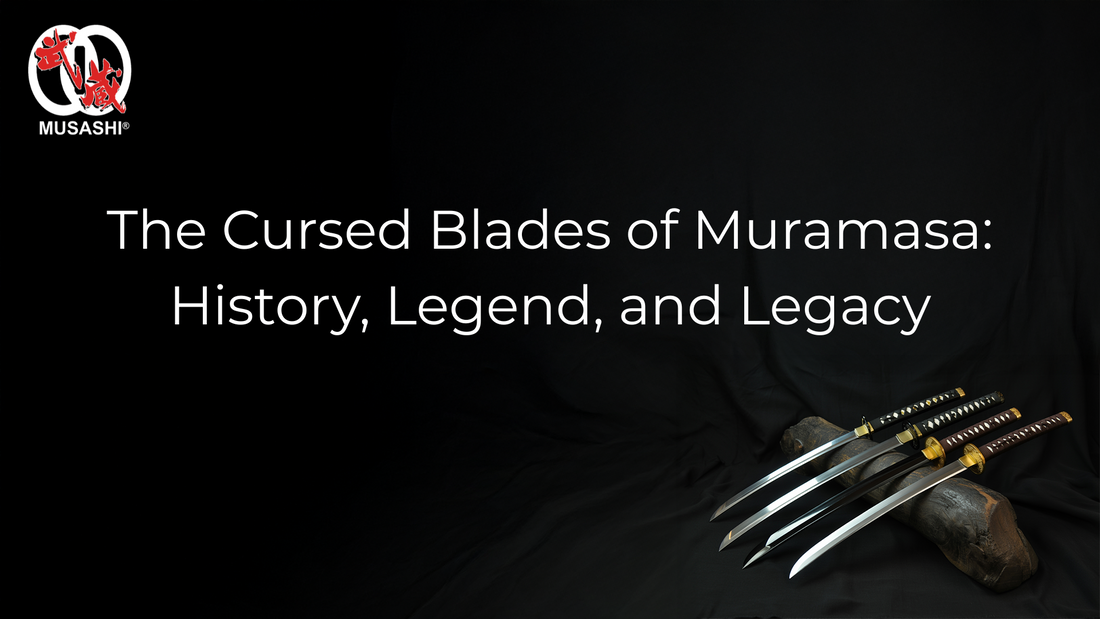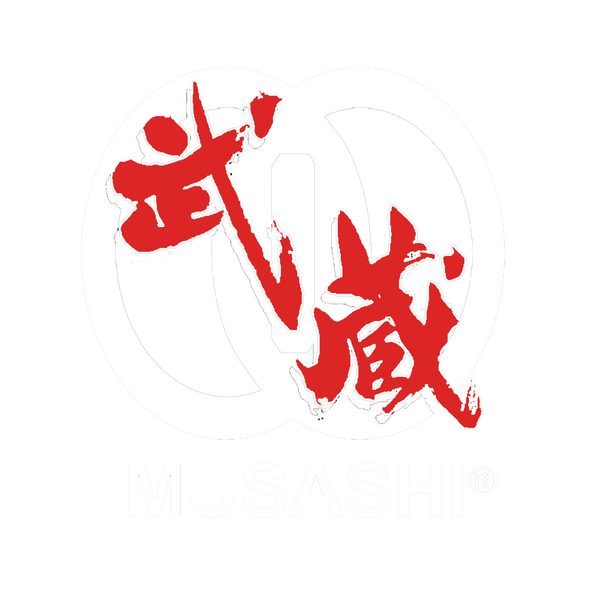
The Cursed Blades of Muramasa - Exploring the Muramasa Legend and Samurai History | Musashi Swords
The Cursed Blades of Muramasa hold a significant place in samurai history, known for their sharpness and the dark curse said to affect their wielders. These Muramasa blades are deeply tied to samurai legend, symbolizing both power and the mysterious curse that surrounds their legacy.
Unveiling the Muramasa Legend
Muramasa Sengo - The Legendary Swordsmith
Early Life and Training
Muramasa Sengo was a well-known Japanese swordsmith. He started his craft with deep respect for old traditions. His training showed great dedication to learning the skills passed down by earlier smiths. This strong focus helped him become a skilled master swordsmith.
Unique Sword-Making Techniques
Muramasa used special methods that made his swords stand out. He worked with traditional techniques but paid close attention to every detail. His swords showed both beauty and strength. These authentic samurai swords became famous for looking great and working well in fights.
Rise to Fame and Recognition
Stories about Muramasa's blades grew with time. Many tales said his swords were cursed or had strange powers. These stories made his work very popular among collectors and fighters. Because of this legendary folklore, Muramasa's name stayed important in history.
The Art of Sword-Making - Traditional Techniques and High-Quality Steel
Materials and Their Sourcing
Good katana craftsmanship starts with top steel. This steel comes from Japanese metallurgy, using iron sand found near Japan's shores. One key steel type is called Tamahagane. It helps make blades that are tough but still flexible. Such steel keeps sharp edges for a long time.
Traditional Forging Process
The sword-making process has many steps:
- Heating the metal (forge)
- Hammering it into shape
- Tempering to make it strong
- Testing the blade's quality (sword blade testing)
Each step needs skill to make sure the katana performs well in use.
Quality Control and Finishing
Every sword gets careful checking during production. Polishing brings out an elegant look while keeping the blade strong. The final product looks timeless and stays durable for many years. These finishing touches honor the skill and tradition behind every blade, like those made by Muramasa Sengo.
When you learn about Muramasa Sengo's life, his special methods, and the materials used, you see why these traditional Japanese katanas have such a strong legacy and cultural significance today.
The Curse of the Muramasa Blades
Legends and Curses - Separating Fact from Fiction
The cursed blades of Muramasa have captured many imaginations. These swords are called cursed samurai swords, believed to bring bad luck or even death. The Muramasa legend started with a swordsmith named Muramasa Sengo. People say his blades had violent spirits. But many samurai blade myths mix true history with made-up stories.
Muramasa swords were sharp and well-made. Over time, tales said these blades pushed warriors to fight too much. This legendary folklore shows how much Japan cared about honor and weapons. It also shows how fear changed how people saw some swords.
Some stories say these blades had a psychological impact on samurai, making them angry or unlucky. But most historians today think that's just exaggeration or cultural bias, not real fact.
Muramasa vs. Masamune - A Tale of Two Swordsmiths
Muramasa and Masamune are two famous names in Japanese swordsmithing history. Both were master swordsmiths who made legendary katanas that many still admire for their artistic mastery and superior quality. But their swords tell very different stories. Muramasa swords are often called "The Cursed Blades of Muramasa." Legends say these blades bring bad luck and bloodshed. Still, they show authentic forging skills with sharp edges and bold designs. The craftsmanship lineage of Muramasa focuses on making swords that work well in battle. These swords are known for their cutting power.
Masamune's blades have a different reputation. They balance beauty and performance well. His work shows respect for tradition but uses smart tempering processes to make elegant hamon patterns—the wavy lines on the blade edge. These patterns show both art and strength.
Contrasting Styles and Philosophies - Examining the Blades
Muramasa and Masamune made swords with very different styles, techniques, and uses:
-
Blade Tempering Process:
Muramasa's method made very hard edges that cut fast but could chip easily. His blades are sharp but less flexible. Skilled users could make deadly strikes with them. - Masamune used advanced tempering to create strong yet flexible blades. His hamon patterns look graceful and show careful katana craftsmanship.
-
Aesthetic Differences:
Muramasa swords look bold and fierce, with strong curves made for fighting more than looking pretty. - Masamune's swords have smooth lines and fine details that reflect old traditions in Japanese swordmaking.
-
Performance Differences:
Both are hand-forged katanas famous worldwide. Muramasas are prized for raw cutting power in battle, while Masamune's blades balance toughness with precise handling for different martial arts.
Knowing these differences helps collectors value each sword's story in samurai culture—the fiery spirit behind "cursed" Muramasas versus the honored legacy of Masamu knives made using authentic forging methods passed down through generations.
Muramasa Blades and the Samurai - Weapons of War and Honor
Muramasa blades stand out among samurai swords in Japan's past. The swordsmith Muramasa Sengo made these blades during Feudal Japan. Samurai warriors prized them because they were sharp and tough. These battle-ready samurai swords showed the warrior spirit well They were real weapons, not just for show like some traditional Japanese swords.
The samurai sword legacy honors skill and usefulness. Muramasa's work shows this clearly. He used high-quality steel and old techniques passed down through many years. The swords look graceful but fight hard. They reflect respect for both honor and battle readiness.
- Made by legendary Muramasa Sengo
- Used as martial arts weapons
- Known for sharpness and strength
- Practical edged weaponry on battlefields
Muramasa Blades in Samurai History
Muramasa blades stand out as some of the most famous samurai swords. They are known for their sharpness and battle-ready design. The swordsmith Muramasa Sengo made them during Japan's Muromachi period. Samurai warriors prized these swords not just for fighting but also as symbols of honor.
These swords show the warrior spirit in samurai culture. They have a curved shape and strong craftsmanship. Unlike fancy katanas, Muramasa blades were made to fight in battles. Stories tell how samurai relied on these swords when war broke out.
Here's what makes Muramasa blades special:
- Sharp edges made for cutting
- Curved shape perfect for quick strikes
- Tough steel built to last in combat
- A symbol of honor for warriors
Muramasa in Popular Culture
Muramasa Blades in Modern Media - Anime, Manga, and Beyond
Muramasa blades pop up a lot in Japanese mythology and legendary folklore today. Anime and manga often feature these legendary katanas as powerful weapons with magical powers.
People see them as both art and deadly tools. Their stories keep samurai values alive in popular culture.
The Enduring Legacy - Muramasa in Film and Literature
Movies and books keep telling stories about these famous swords. They mix real history with myths to create dramatic tales.
This legacy shows how Muramasa goes beyond being just weapons—they are part of culture. These swords represent honor made real by skillful work.
Things to remember about their legacy:
- Often shown with dramatic stories in film and books
- Mix history with folklore for strong impact
- Seen as cultural icons, not just tools
- Symbolize honor tied to great craftsmanship
The Legacy of Muramasa and the Preservation of History
Muramasa Blades Today - Museums, Collections, and the Future
Today's sword makers still use forging techniques from master smiths like Muramasa Sengo. Japanese museums show real examples with unique forged steel properties.
Collectors hunt down restored pieces that follow strict historic preservation rules, often relying on our katana maintenance service to keep their blades in pristine condition. They want to keep these works authentic and ready for future generations.
What matters now:
- Authentic forging methods remain alive
- Museum collections display real Muramasa blades
- Collectors focus on restoration without losing quality
- Historic weapons stay preserved carefully
Muramasa Blades Today - Museums, Collections, and the Future
Muramasa blades still hold a special place in Japanese sword preservation. These swords show sharpness and unique skill from authentic forging methods used long ago. Many of these forged steel swords sit in well-known Japanese museum collections. They connect us to samurai blade legends and Japan's martial past.
Collectors everywhere want these historic weapons because they are rare and meaningful. Sword appraisal helps tell real Muramasa blades from copies. Careful restoration and climate-controlled storage keep the swords safe. The future of Muramasa blades depends on people who care about historic weapon preservation. Museums and collectors work hard to protect these blades. That way, traditional katana making can live on for many years.
The Continuing Influence - Muramasa's Impact on Swordmaking and Culture
The Muramasa legend goes beyond just the swords themselves. It shapes how people see craftsmanship legacy in samurai culture today. Muramasa made swords with superior quality by using traditional techniques handed down by master swordsmiths skilled in Japanese metallurgy.
His artistry still affects swordmakers now. They honor this lineage by mixing old ways with some new ideas. This keeps both technical skill and cultural meaning alive in every blade.
Through his lasting impact on traditional katana making, Muramasa's name stands for respect for history, careful artistry, and strong dedication—values at the heart of samurai culture.
FAQs
What is the significance of samurai sword legacy in Japanese culture?
The samurai sword legacy represents honor, discipline, and skill. It reflects centuries of craftsmanship and the warrior spirit in Japan's history.
How does samurai sword history influence modern sword enthusiasts?
Samurai sword history guides collectors and makers today. It preserves traditional forging techniques and respects cultural values tied to these swords.
What role do forged steel types play in making Muramasa blades?
Forged steel types like Tamahagane provide strength and sharpness. They ensure Muramasa blades maintain cutting power and durability in battle.
Why is sword appraisal important for authentic Muramasa blades?
Sword appraisal verifies a blade's origin, condition, and value. It helps collectors identify real Muramasa swords from replicas or fakes.
What are historical sword replicas and why do collectors value them?
Historical sword replicas recreate famous blades using traditional methods. Collectors value them for education and preserving samurai heritage.


